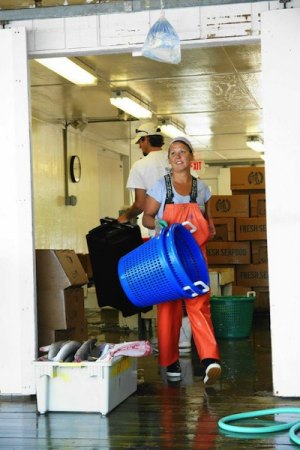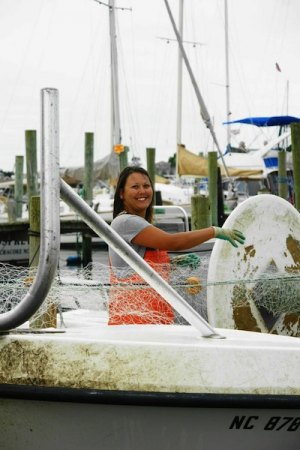Ocracoke's Fisherwoman
Tree moved to Ocracoke from Winterville, NC eighteen years ago, to be closer to her father, artist Bob Ray. She hasn’t looked back. She describes herself as a “tomboy” and has always had a love for nature and desire to work outside, primarily favoring labor-intensive jobs. Before becoming a working waterwoman, Ray was a massage therapist, and while she enjoyed that time, she longed to be outdoors. As a young adult she learned to hunt, live off nature, and create objects, such as journal covers, from animal skins, which she tanned herself. During, what she calls a “transitional time,” she grew to fully appreciate nature and her surroundings, and also realized she was a very strong, self-sufficient person.
Tree’s days typically start around 4am, and by 5 o’clock she is out on the water, fishing about a two-mile stretch in the Pamlico Sound called Blair’s Channel. As first mate on Hardy Plyler’s boat, she has a wide array of responsibilities, which include gathering ice before heading out on the water, setting nets, and doing any net repairs. Nets frequently get snagged on objects underwater, such as rocks and tree limbs, but most rips are repairable. When a net has been ripped too much to repair, new netting is purchased, which Tree hand-sews to make them the necessary sizes for what they need.
There is more to being a waterwoman than learning how to catch fish. Tree said knowing the weather plays a huge role in what can be caught, and even though fishing here isn’t “like the Deadliest Catch or anything, “ strong winds still pose risks and can hinder a day’s fishing outing. Once the wind reaches 28mph she explained it becomes dangerous to be on the water. Added risk comes with lightning, so in severe weather events she and the captain must return to the dock. Low pressure systems can be a good thing for fishermen and women because it stirs the water, creating movement of the sea-life.

To be a successful on the water, Tree said you have to have, “patience, a great work ethic, and be able to think quickly.” Being able to recognize potential problems before they happen and knowing how to either prevent the problem or fix it, if one occurs, is essential to being successful. She went on to say that someone who works in this industry has “got to be a good listener and cannot make excuses. Be there because you want to be there, and know you want to be there.”
Around 11 o’clock, Tree and Hardy return to the dock, but have more tasks to complete. Tree cleans the morning’s catch, which is then sold in Ocracoke's fish house and various local restaurants, and does any booking that needed to either add businesses or keep businesses supplied with fresh, local seafood.
By 2:30 in the afternoon she is usually back out on the water with Captain Plyler, hoping to bring in more fresh fish. The height of fishing season may be slowly winding down now with cooler weather making its way here, gradually lowering the water temperature, but when the water begins to warm in late-April and May, her busy days resume and last through the summer. When the water reaches 72 degrees (F) and warmer, the fish are typically plentiful. A nice westerly wind is also great as it brings in many fish and makes a large catch possible. Once we reach the fall and winter months, fishing declines when the water temperature drops below 60 degrees (F), which is just too cold for the fish to survive.
While Tree makes her living from catching, cleaning, and selling fish, she also has the utmost respect for nature. If a sea turtle gets into the netting, for example, she always releases it back into the water. She will also not hesitate to report a sea turtle that has been stunned by the cold, a fairly common occurrence along the Outer Banks. On one occasion, hundreds of sea horses became caught in a net, along with valuable fish. At that point her primary concern was getting the sea horses out of the net, which she did, and was still able to catch a significant amount of fish. Tree strongly believes that any animal not needed for food should be released back into the water, a belief she sticks to firmly.
When Tree isn’t fishing she enjoys spending time with her family, friends, and dog, as well as traveling to Morehead City for the annual Seafood Festival to represent the Ocracoke Working Watermen’s Association (OWWA). About her choice of career and life on Ocracoke, Tree said, “I love it here! I live everyday like it’s summer camp!” She went on to say that had she not become a commercial fisherman, she probably would’ve joined the Peace Corps or gone to vet tech school in Colorado.
For more information about OWWA, you can go to their website: www.ocracokewatermen.org or visit the Watermen’s Exhibit located on the docks at the Community Square along Silver Lake. Visit Ocracoke Seafood Company (the retail store at the fish house) to buy some local seafood for your supper. They can tell you if Tree caught it!
Editor's note: This article is the first in a new series that Crystal calls "Ocracoke Women Being Awesome." Go, Crystal!




